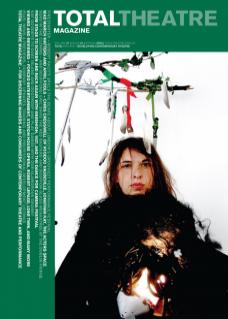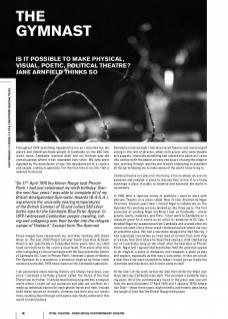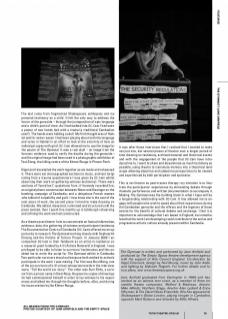Throughout 1979 something happened to me as I watched the displaced and disenfranchised people of Cambodia on the BBC television news, Cambodia inserted itself into my thirteen-year-old consciousness where it has resonated ever since. My eyes were appalled by the devastation of war, the abandonment of a country and people, ending in genocide. For the first time in my life I felt a witness to atrocity.
Those images have stayed with me, and after working with David Glass on The Lost Child Project (all over South East Asia & South America but specifically in Cambodia) thirty years later, my childhood connections to the country resurfaced. Five years after that, after instigating a cultural exchange with the Documentation Centre of Cambodia (DC-Cam) in Phnom Penh, I devised a piece of theatre, The Gymnast, as a testament; a memorial inspired by those initial reactions to the BBC 1979 news report on the Cambodian genocide.
I am passionate about making theatre and always have been, ever since I received a birthday present called The Horse of the Year Show from my Father. I transformed that board game into a magical world where I could act out scenarios and play out conflicts as I made up individual stories for each plastic horse and rider. I would build these stories to dramatic climaxes and then play out resolutions, working them through until peace was finally restored in this world of make believe.
Somewhat unknowingly I had discovered theatre and found myself acting in the role of director, albeit with actors who were models and puppets. Internally something had slotted into place as I came into contact with the power, privacy and luxury of using the imagination, working through realities and dreams attempting to assemble all the parts helping me to make sense of the world I was living in.
I believe theatre is a place for the living, a forum where we are empowered and enabled, a place to discuss how to live. It is a living exchange a place in public to examine and excavate the world in its entirety.
In 1992 after a rigorous series of auditions I went to work with Volcano Theatre on a piece called How To Live, directed by Nigel Charnock. Sixteen years later I invited Nigel to collaborate on The Gymnast. Our working process divided up into three parts. The first consisted of sending Nigel anything I had on Cambodia – photographs, books, websites, and films. I then went to Cambodia on a research grant for a month as an artist in residence at DC-Cam. I emailed Nigel my experiences from Cambodia and a week after my return we went into a three-week rehearsal period where we constructed the piece. We had a wardrobe designed by Neil Murray. I had requested a wardrobe as I had read an extract from John Pilger’s essay Year Zero where he described seeing a child clambering out of a wardrobe lying on the street after the liberation of Phnom Penh. Nigel and I agreed that wardrobes held the potential appeal to be magical, a place to disappear and reappear, a place to play and explore, especially as this was a solo piece. In fact we struck a deal that if we were stumped for ideas I would just go inside the wardrobe and stay there, but it never came to that!
At the heart of the work lurked the idea that whilst the West was disco dancing, Cambodia went dark. This provided a symbolic starting point. All of the contemporary music in the piece was sourced from the period between 17 April 1975 and 7 January 1979 (Liberation Day) – those three years, eight months, and twenty days being the length of time that the Khmer Rouge held power.
The text came from fragmented Shakespeare soliloquies and my personal testimony as a child. It felt the only way to address the horror of the genocide – through the juxtaposition of epic language and a child’s point of view. As I had walked into DC-Cam I had seen a poster of two hands tied with a krama (a traditional Cambodian scarf). The hands were holding a skull. My first thought was of Hamlet and for some reason I had been playing about with the language and verse in Hamlet in an effort to look at the enormity of how an individual copes with grief. DC-Cam allowed me to use the image for the poster of The Gymnast. It was a real skull – an image from the forensic evidence used to verify the deaths during the genocide – and the original image had been used in a photographic exhibition at Toul Sleng, the killing centre of the Khmer Rouge in Phnom Penh.
Nigel and I dovetailed the work together as we made and rehearsed it. There were set choreographed sections to music, and text (originating from a trauma questionnaire I was given by DC-Cam whilst observing their work on gathering witness testimony). There were sections of ‘found text’: quotations from J F Kennedy recorded live; an original phone conversation between Nixon and Kissinger on the bombing campaign of Cambodia; and a ubiquitous French woman who talked of culpability and guilt. I now know she is the soul of the next piece of work, the second piece I intend to make drawing on Cambodia. We edited, dissected, ruminated and structured until the piece existed, then I spent five months up in Edinburgh rehearsing and refining the work we had constructed.
As a theatre practitioner I aim to concentrate on factual information, evidence, data, the gathering of witness and participant testimony. The Documentation Centre of Cambodia (DC-Cam) offered me an opportunity to research The Gymnast working closely with Sophearith Choung and the Victims of Torture Project. In January 2008 I accompanied DC-Cam in their fieldwork as an artist-in-residence on a research grant funded by A-N (Artists Network) in England. I was privileged to be able to listen to survivors’ testimonies and this enabled me to write the script for The Gymnast whilst in Cambodia. Two particular survivors stood out because both wished to actively participate in the work I was making. The first was Bou Meng, one of the six survivors of S-21 prison whose last words in the interview were, “Tell the world our story”. The other was Sum Rithy, a survivor from a prison camp in Siem Reap. He gave me copies of drawings he had commissioned himself in order to lay witness to his experiences and talked me through his thoughts before, after, and during his incarceration by the Khmer Rouge.
It was after these interviews that I realised that I needed to make not just one, but several pieces of theatre over a longer period of time drawing on testimony, archived material and historical events and with the engagement of the people that DC-Cam have introduced me to. I want to share and disseminate as much testimony as possible, using theatre to transmute memory into a theatrical landscape allowing objective and subjective perspectives to be viewed and experienced by both participator and spectator.
This is not theatre as post-trauma therapy; my intention is to illustrate the participants’ experiences by stimulating debate through dramatic performance and written documentation to accompany it. Making The Gymnast was the building block in what I hope will be a long-standing relationship with DC-Cam. It has allowed me to engage with people who wish to speak about their experiences during the Cambodian genocide and the effects and the legacies of those events for the benefit of cultural debate and exchange. I feel it is important to acknowledge that I am based in England, but nonetheless that the work I am developing could contribute to the active and progressive artistic culture already present within Cambodia.
The Gymnast is written and performed by Jane Arnfeld and produced by The Empty Space theatre development agency with the support of Arts Council England. Co-direction by Nigel Charnock, design by Neil Murray, music by John Alder and lighting by Malcolm Rippeth. For further details and future plans, see www.theemptyspace.org.uk
Jane Arnfeld graduated from Dartington in 1988 and has worked as an actress ever since, as a member of three ensemble theatre companies: Method & Madness, director Mike Alfreds; Northern Stage, director Alan Lydiard & Erica Whyman; & The David Glass Ensemble. She has appeared at Shakespeare’s Globe London, playing Imogen in Cymbeline, opposite Mark Rylance and directed by Mike Alfreds.


